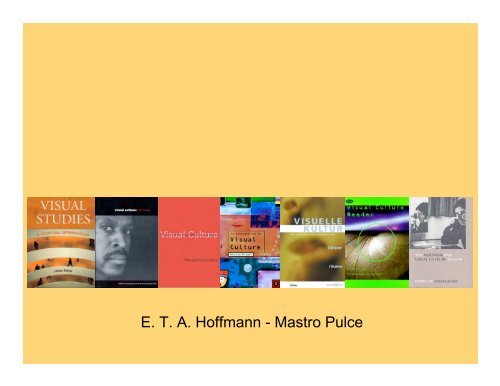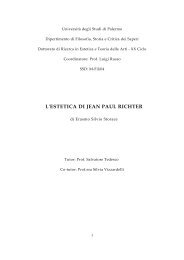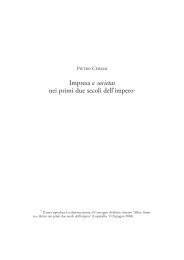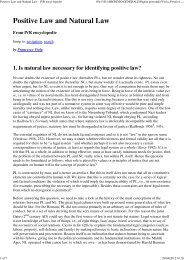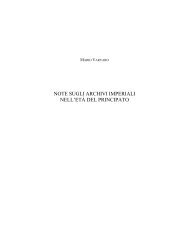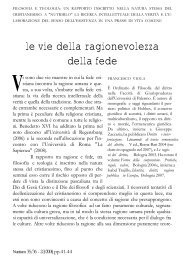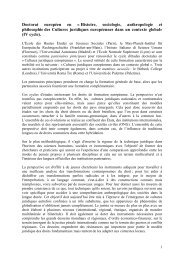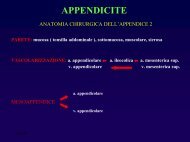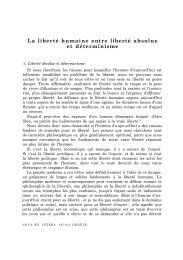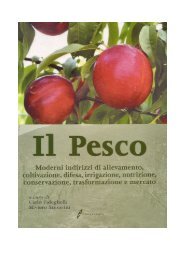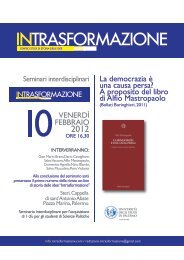E. T. A. Hoffmann - Mastro Pulce
E. T. A. Hoffmann - Mastro Pulce
E. T. A. Hoffmann - Mastro Pulce
Create successful ePaper yourself
Turn your PDF publications into a flip-book with our unique Google optimized e-Paper software.
E. T. A. <strong>Hoffmann</strong> - <strong>Mastro</strong> <strong>Pulce</strong>
L’officina di E. T. A. <strong>Hoffmann</strong> (1776-1822)
Meister Floh: un arabesco letterario<br />
• Racconto di Natale<br />
• Racconto d’avventura (Barocco)<br />
• Racconto fiabesco (Märchen romantico) + arabesco/strano (das<br />
Wunderliche = das Unheimliche)<br />
• Racconto utopico (la repubblica delle pulci)<br />
• Satira politico-giudiziaria (Knarrpanti)<br />
• Satira contro la scienza (Leuwenhoeck-Swammerdamm)<br />
• Parodia (goethiana)
LETTORE<br />
malevolo<br />
benevolo<br />
LETTRICE<br />
bella<br />
Un’opera moderna<br />
ELEMENTI<br />
METATESTUALI<br />
riflessioni poetologiche<br />
appello al lettore<br />
EDITORE<br />
(curatore)<br />
fiaba<br />
(Märchen)<br />
NARRATORE<br />
(di fiabe)<br />
romanzo<br />
(Roman)<br />
ASCOLTATORE<br />
satira<br />
(Knarrpanti)
INTERTESTUALITÀ<br />
numerose fonti<br />
implicite ed esplicite<br />
Arpe, Bayle, Gozzi etc.<br />
molti riferimenti<br />
alle opere dello stesso <strong>Hoffmann</strong><br />
Un’opera moderna<br />
MEISTER FLOH<br />
(1822)<br />
INTERMEDIALITÀ<br />
le copertine<br />
realizzate da<br />
Carl Friedrich Thiele<br />
INTERCULTURALITÀ<br />
rapporto tra regno minerale, animale<br />
vegetale e uomo
GOETHE<br />
Wilhelm Meister<br />
GOETHE<br />
Werther<br />
GOETHE<br />
Faust<br />
MOZART<br />
Il ratto del serraglio<br />
J. F. JÜNGER<br />
Il ratto<br />
CARLO GOZZI<br />
L'amore delle tre melarance<br />
INTERTESTUALITÀ<br />
SWAMMERDAMM<br />
Biblia naturae<br />
Girolamo Rorario<br />
Filone<br />
Justus Lipsius<br />
G. W. Leibniz<br />
Gomez Pereira<br />
Maimonide<br />
C. A. F. Kluge<br />
Michael Ranfft<br />
Orazio<br />
Stanilaus de Bouflers<br />
Brentano<br />
PETER FRIEDRICH ARPE<br />
SCHUBERT<br />
La simbolica del sogno<br />
(1814)<br />
PIERRE BAYLE<br />
Dictionnaire<br />
(1695-97)
Il simbolismo della copertina
I regni della natura/Dall’inconscio al conscio<br />
Carbonchio<br />
(pietra)<br />
inconscio<br />
Cardo, tulipano<br />
etc.<br />
(pianta)<br />
pre/inconscio<br />
<strong>Pulce</strong><br />
(animale)<br />
pre/inconscio<br />
Pellegrinus<br />
(uomo)<br />
Conscio<br />
sogno
Carbonchio (granato) - Karfunkel<br />
«Considerate attentamente il punto rosso nel mezzo della tavola.<br />
Quel punto non è solo voi stesso, è anche la forma di cui, nel<br />
passato, il vostro principio psichico non poteva diventare cosciente.<br />
Eravate allora un carbonchio sfolgorante che giaceva nelle profonde<br />
viscere della terra»
REALTA'<br />
LÄMMERHIRT<br />
(legatore di libri)<br />
KNARRPANTI<br />
DUE DELEGATI<br />
DEL CONSIGLIO SUPREMO<br />
(Kafka)<br />
GIOVANOTTO<br />
DUE RAGAZZE<br />
MEDICO<br />
VECCHIO MERCANTE<br />
ROSETTA<br />
REALTA'<br />
DELIRANTE<br />
PELLEGRINO TYSS<br />
(Baldassarre Tyss - padre di)<br />
ALINA<br />
DÖRTJE ELVERDINK<br />
(donna esposta)<br />
ALINA (principessa)<br />
GEORG PEPUSCH<br />
VECCHIO DECREPITO<br />
(mago)<br />
GIOVANE UFFICIALE<br />
La (ir)realtà letteraria<br />
MEISTER FLOH<br />
Personaggi<br />
REVENANTS<br />
(MONDO INTERMEDIO)<br />
SWAMMER(DAMM)<br />
LEUWENHOEK<br />
(domatore di pulci)<br />
ISACCO BEN HARRAVAD<br />
ASHAVERUS<br />
EBREO ERRANTE<br />
FANTASIA<br />
INCONSCIO<br />
RE SEKAKIS<br />
(Famagosta)<br />
REGINA DI GOLCONDA<br />
PRINCIPESSA GAMAHEH<br />
CARDO ZEHERIT<br />
Cactus grandiflorus<br />
PRINCIPE SANGUISUGA<br />
(vampiro)<br />
GENIOTHETEL<br />
LETTERATURA<br />
MITO<br />
OROLOGIAIO DEGEN<br />
SARTORELLO DI SACHSENHAUSEN<br />
LINDHORST<br />
archivsta dal racconto<br />
Il Vaso d'oro
Jakob Degen, l’orologiaio di Vienna, (1760-1848)
Jakob Degen, L’Ornithopher, (1760-1848)
Lämmerhirt<br />
Moglie<br />
Rosetta<br />
Figli<br />
Pellegrino Tyss<br />
Alina<br />
Dörtje Elverdinck<br />
Georg Pepusch<br />
Leuwenhoeck<br />
Swammerdamm<br />
Re Sekakis<br />
Regina di Golconda<br />
Principessa Gamaheh<br />
Cardo Zeherit<br />
Principe Sanguisuga<br />
Genio Thetel
Stati alterati della coscienza<br />
«parlava al suo spirito solo il meraviglioso, che commuoveva la sua<br />
fantasia e in cui egli viveva e si animava» (Pellegrinus)<br />
«sogno delirante» (Pellegrinus)<br />
«allucinazione»<br />
«quella sorta di delirio che precede il sonno» (Pellegrinus)<br />
«in uno stato quasi sonnambolico» (Alina-Gamaheh)<br />
«Non vi siete mai accorto di credere alle immagini di sogno?… Abbozzi<br />
di ciò che fu o che forse ancora deve esistere, sono queste figurazioni<br />
che lo spirito improvvisa a suo piacere, quando il tiranno chiamato<br />
corpo lo proscioglie della sua schiavitù»<br />
«un uomo in pieno parossismo»<br />
«come nei sogni che uniscono quanto v’ha di più eterogeneo, e nei<br />
quali si definisce stravagante tutto ciò di cui non si sa afferrare il nesso<br />
profondo»
Franz Anton Mesmer (1734-1815)
Franz Anton Mesmer (1734-1815)
Pellegrino Tyss<br />
Da bambino:<br />
immobile insensibilità<br />
piccolo automa<br />
disturbi della parola<br />
eccesso di fantasia<br />
Da uomo maturo:<br />
36 anni<br />
«ipocondria morbosa<br />
«misantropo/misogino<br />
(disturbi della sessualità)»<br />
«buono a nulla»<br />
conflitto con il padre<br />
«un tramenio che confina<br />
con la follia»
Georg Pepusch<br />
«Malinconico e<br />
irritabile»<br />
«cupo, chiuso in se<br />
stesso e sovente<br />
anche ingiusto»
IMMAGINE<br />
FOTOGRAFIA<br />
CULTURA VISUALE<br />
DISPOSITIVO<br />
MICROSCOPIA<br />
SGUARDO<br />
CYBORG
Un’antropologia dell’immagine<br />
• Zauberbilder<br />
• Wunderbilder<br />
• Vexierbilder<br />
• Schattenbilder<br />
• Scheinbilder<br />
• Medusenbilder<br />
• Schreckbilder<br />
• Luftbilder<br />
• Zerrbilder<br />
• Teufelsbilder<br />
• Ebenbilder<br />
• Spiegelbilder<br />
• Trugbilder<br />
• Gaukelbilder
Alina - Principessa Gamaheh - Dörtje Elverdink
Perversioni dello sguardo: voyeurismo<br />
«Voglio scendere a guardare dal<br />
buco della chiave… La dama se<br />
ne stava sdraiata sul sofà… e<br />
Pellegrino trovò che nessuna<br />
lingua umana avrebbe potuto<br />
esprimere con parole l’incanto<br />
paradisiaco che era diffuso sulla<br />
sua soave figura. Il suo<br />
abbigliamento (effettivamente uno<br />
zendado d’argento con strani<br />
ricami di vari colori)era<br />
assolutamente fantastico…»<br />
«una pupattolina incantevole e<br />
piena di grazia»<br />
«il vantaggio di potersi fingere<br />
inosservata» (Alina)
DONNA<br />
(sessualità)<br />
ALINA-DÖRTJE-GAMAHEH<br />
Leuwenhoek<br />
Swammerdamm<br />
Pellegrino Tyß<br />
Georg Pepusch<br />
Sanguisuga<br />
Thetel<br />
<strong>Mastro</strong> <strong>Pulce</strong><br />
Fenomenologia “desiderio”<br />
MEISTER FLOH<br />
Fenomenologia del possesso<br />
e/o del desiderio<br />
MEISTER FLOH<br />
(economia, politica)<br />
+<br />
(sessualità)<br />
Dörtje Elverdink Leuwenhoek<br />
Swammerdamm<br />
MICROSCOPIO OCULARE<br />
(conoscenza)<br />
Leuwenhoek<br />
Swammerdamm<br />
Meister Floh<br />
Pellegrino Tyß<br />
CARBONCHIO<br />
(Tilsemoth/Tsilmenaja)<br />
Leuwenhoek<br />
Swammerdamm
LENTE DI<br />
INGRANDIMENTO<br />
(Lupe)<br />
MICROSCOPIO<br />
NOTTURNO<br />
MICROSCOPIO SOLARE<br />
MICROSCOPIO<br />
DI JOHN CUFF<br />
MICROSCOPIO<br />
UNIVERSALE<br />
DI ROßWURM<br />
FISICOTEOLOGIA<br />
(il mondo di Dio)<br />
Visibile vs Invisibile<br />
MICROSCOPIO<br />
OCULARE<br />
TECNOLOGIA<br />
(aberrazioni cromatiche<br />
sferiche etc.)<br />
DISPOSITIVI DELLA VISIONE<br />
UTILIZZO LUDICO<br />
SPETTACOLO<br />
ILLUSIONE<br />
LATERNA MAGICA CANNOCCHIALE<br />
(Tubus, Fernglas)<br />
CANNOCCHIALE<br />
DI STRANA FORMA<br />
= CALEIDOSCOPIO<br />
BUCO DELLA SERRATURA<br />
FINESTRA<br />
AEROSTATO<br />
VETRINA
Il domatore di pulci – Leuwenhoek + (Swammer)
Robert Hooke, Micrographia, 1665
Robert Hooke, The Flea, 1665
Robert Hooke, The Flea, 1665
Robert Hooke, The Flea, 1665
Robert Hooke, Microscopio composto, 1665
Hooke's compound microscope and its illuminating system, 1665-1675. Full-size<br />
reconstruction of Robert Hooke's (1635-1703) compound microscope copied from the engraving<br />
and description in his book 'Micrographia' (1665), the first important work on microscopy. The<br />
microscope was focused by moving and turning the microscope on a screw thread, rather than<br />
moving the specimen, which was mounted on a spike. The eyepiece lens was at the top of the<br />
microscope and an objective lens next to the specimen. Hooke inserted a field lens between<br />
these in order to increase the field of view. He used his pioneering compound microscope, with<br />
its two lens systems, to examine a flea, a piece of cork and many other specimens. The<br />
illumination system used a liquid-filled globe to project the flame of an oil lamp onto the<br />
specimen.
Antoni van Leeuwenhoek (1632-1723)
Antoni van Leeuwenhoek (1632-1723)
Antoni van Leeuwenhoek (1632-1723)
Antoni van Leeuwenhoek (1632-1723)
Antoni van Leeuwenhoek (1632-1723)
Simple microscopes, 17th century. Simple microscopes by Leeuwenhoek, copy,<br />
Musschenbroete and Depouilly. The Leeuwenhoek is an exact copy of the original,<br />
made before 1673 and in the possession of the University Museum, Utrecht. It<br />
consists of a double convex lens mounted between two concavities, provided with<br />
minute apertures made in two thin brass plates which are riveted together. The<br />
object to be examined is held in front of the lens on the point of a short rod mounted<br />
on a small brass block loosely riveted to a long coarse-threaded screw. Blue<br />
background.
Antoni van Leeuwenhoek (1632-1723)
Antoni van Leeuwenhoek (1632-1723) (Vermeer)
Antoni van Leeuwenhoek (1632-1723)
Antoni van Leeuwenhoek (1632-1723)
Antoni van Leeuwenhoek (1632-1723)
Antoni van Leeuwenhoek (1632-1723)
Antoni van Leeuwenhoek (1632-1723)
Animalcule - Homunculus


